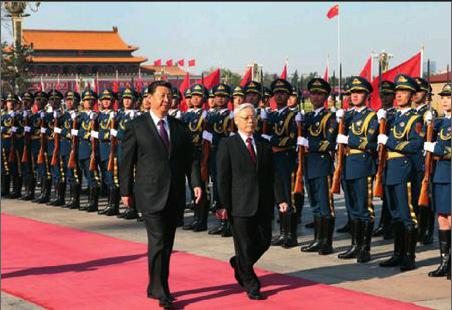Partnership Reestablished
2015-05-26ByYuLintao
By+Yu+Lintao

Accompanied by about one third of top party officials, Viet Nams Communist Party General Secretary Nguyen Phu Trong recently paid an official visit to Beijing, where he received a warm welcome from top Chinese leadership. The trip came as the two Asian neighbors celebrate the 65th anniversary of the establishment of their diplomatic relations.
In meetings, the two sides once again stressed their “brotherly” friendship. The anniversary serves as an opportunity to further fortify their time-honored ties. The latest stroke of top-level diplomacy between Beijing and Hanoi shows that the two neighbors relations have been restored since the escalation of their maritime disputes last May. The visit will help the two countries further cement their traditional friendship and consolidate their comprehensive strategic cooperative partnership, they said.
When meeting with Chinese President Xi Jinping in Beijing, Trong said their countriestraditional friendship was formed by late Vietnamese leader Ho Chi Minh and Chinese leader Mao Zedong—a legacy that should be continued in the present day.
Xi, also General Secretary of the Central Committee of the Communist Party of China, proposed that the two sides uphold SinoVietnamese friendship as well as their mutual development. He said China and Viet Nam are facing both new opportunities and challenges as the international situation undergoes complex and profound changes. He suggested the two parties, as well as the two countries, boost high-level interactions to find new solutions to their problems and to advance the bilateral relationship in a sustained way.
Observers said that although bilateral relations were affected by their maritime dispute in the past year, the dispute does not equal the whole picture of the China-Viet Nam relations. The two countries not only enjoy a profound traditional friendship but are also in the process of seizing opportunities for future cooperation.
Traditional friendship
Historically, the two countries enjoyed a strong and lasting bond, featuring “good neighbors, good friends, good comrades and good partners.” Over 50 years ago, during the U.S. invasion of Viet Nam, upon the request of the Vietnamese Communist Party and the Viet Nam people, more than 320,000 Chinese troops were sent to the country to help defend its sovereignty and unity. More than 1,400 Chinese soldiers were laid to rest after giving their lives in Viet Nam.
Wang Xiaopeng, a researcher at the Chinese Academy of Social Sciences (CASS), noted that the two sides aim to solve persistent territorial problems.
In mid-May last year, a series of riots targeting foreign companies broke out in southern and central Viet Nam, leaving five Chinese nationals dead, around 20 foreign factories burned down, some 1,100 foreign companies affected. The violence came amid tensions between China and Viet Nam over territorial disputes in the South China Sea.
Despite the cacophony, Beijing has insisted on improving bilateral relations with Hanoi, managing differences in a constructive way, and resolving disputes through friendly negotiations.
Wang said the two countries have historically accumulated successful experiences in maritime delimitation, which can be drawn upon for the settlement of the current disputes in the South China Sea. Moreover, in the past decades, China and Viet Nam have successfully put the border clashes behind and joined hands to embrace development opportunities.
In a joint communiqué signed during Trongs visit, the two governments reaffirmed their commitment to manage disputes, comprehensively implement the Declaration on the Conduct of Parties in the South China Sea, reach a Code of Conduct through negotiations at an early date, and avoid taking actions that could complicate and escalate the situation.
Pan Jine, a researcher on Vietnamese studies with the CASS, said Trongs Beijing trip demonstrates the determination of both governments to create a sound neighborhood.
Pan, who made a recent research visit to Viet Nam, said Vietnamese scholars had defined the period of maritime disputes as being the worst in the history of bilateral ties between the two countries since 1979, and that they expect China-Viet Nam relations to stabilize.
“The top officials of the two countries have also reached consensus. The high-level exchange visits are an important symbol for the thawing of bilateral relations,” said Pan. She added that Viet Nam also expects Chinese President Xi to visit Hanoi within the year.
With both countries at a key stage of reform, observers noted that the two sides must seize every chance to gather momentum and strengthen cooperation so as to bring more tangible benefits to their respective peoples.
Future cooperation
Vietnamese data show that economic ties between Viet Nam and China, its largest trading partner, have continued to grow in the past years despite the maritime disputes. Trade volume saw double-digit growth last year, reaching$58 billion.
Statistics from Chinas Ministry of Commerce show that China has been Viet Nams largest trading partner for nine years in a row, while the latter has become Chinas second largest trading partner in the Association of Southeast Asian Nations.
In an interview with China Daily, Hoang The Anh, an expert at the Institute of Chinese Studies at the Viet Nam Academy of Social Sciences, said the latest top-level exchanges between the two countries could get the bilateral relations back onto a healthy track and encourage communication between diplomats, scholars and the public to resolve existing problems peacefully.
Anh, who hailed Viet Nams participation in the China-proposed Asian Infrastructure Investment Bank (AIIB), stressed that both countries should share their experience in different areas, including the economic sector.
Wang with the CASS noted that the Chinaproposed 21st-Century Maritime Silk Road initiative will bring great potential for Viet Nams economic development.
The initiative, which advocates increasing regional interconnection and speeding up construction of regional infrastructure, will undoubtedly boost trade along the way. It will also reduce the odds of conflict as more frequent exchanges of commodities and ideas will lead to better understanding between trading partners. China has invited Viet Nam to join the program.
As Viet Nams infrastructure lags behind, joining the AIIB and the Silk Road initiative conform to the Southeast Asian countrys development needs, said Pan.
A string of deals for economic coopera- tion were signed between the two sides during Trongs trip, including accelerating China-Viet Nam joint oil exploration in PanBeibu Gulf and an MOU on finance and currency cooperation.
According to the joint communiqué, both sides are also working on a border trade agreement to facilitate stronger trade ties, and have agreed to boost infrastructure connectivity projects as well as cooperation in areas such as agriculture, manufacturing, service industry, technology, and health care.
